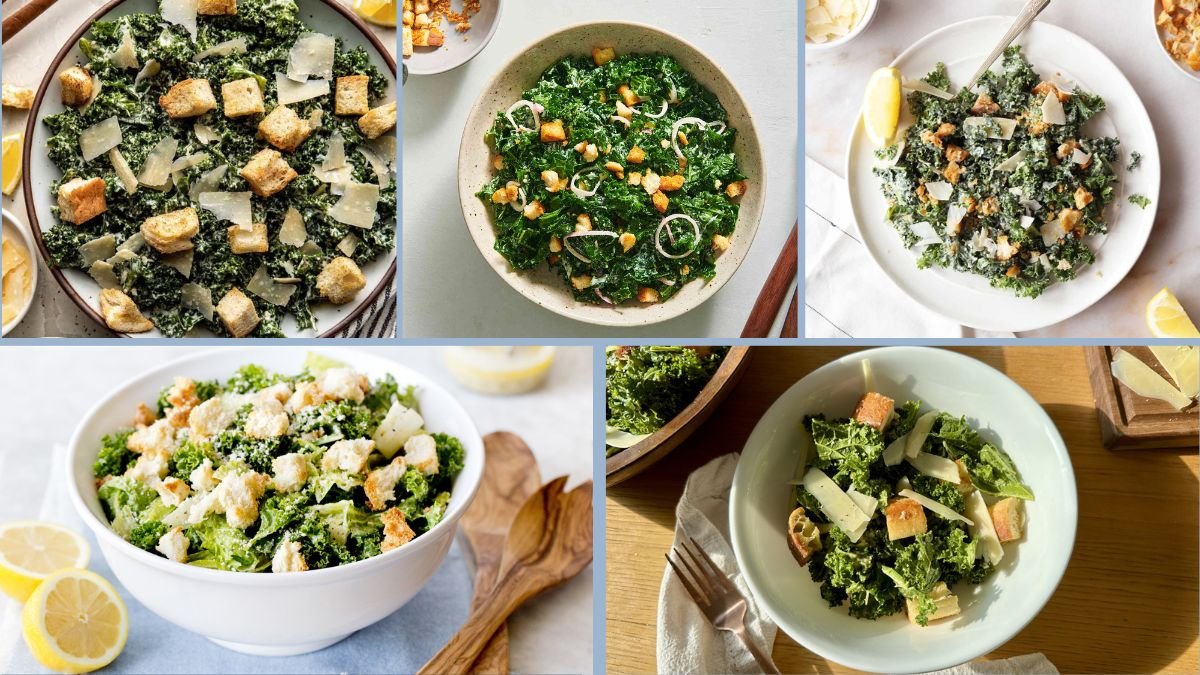The Caesar salad is one of the most beloved dishes in Western cuisine. Known for its bold, creamy dressing and crunchy croutons, it has long been a staple in restaurants and homes alike. However, the traditional Caesar comes with two major limitations: it’s often made with anchovies and sometimes non-vegetarian Parmesan, which excludes many people from enjoying it—especially those following a vegetarian or plant-based diet.
Enter the Kale Caesar, a modern, healthier twist that brings bold flavor, maximum crunch, and plenty of nutrients—without anchovies, meat, or fish-based ingredients. This version uses kale instead of romaine, offering deeper flavor and better nutrition, while the dressing is reimagined using fully vegetarian ingredients.
Here are 9 essential secrets to making the best crunchy kale Caesar salad at home—completely vegetarian and absolutely satisfying.
Secret 1: Use Lacinato Kale for Best Texture
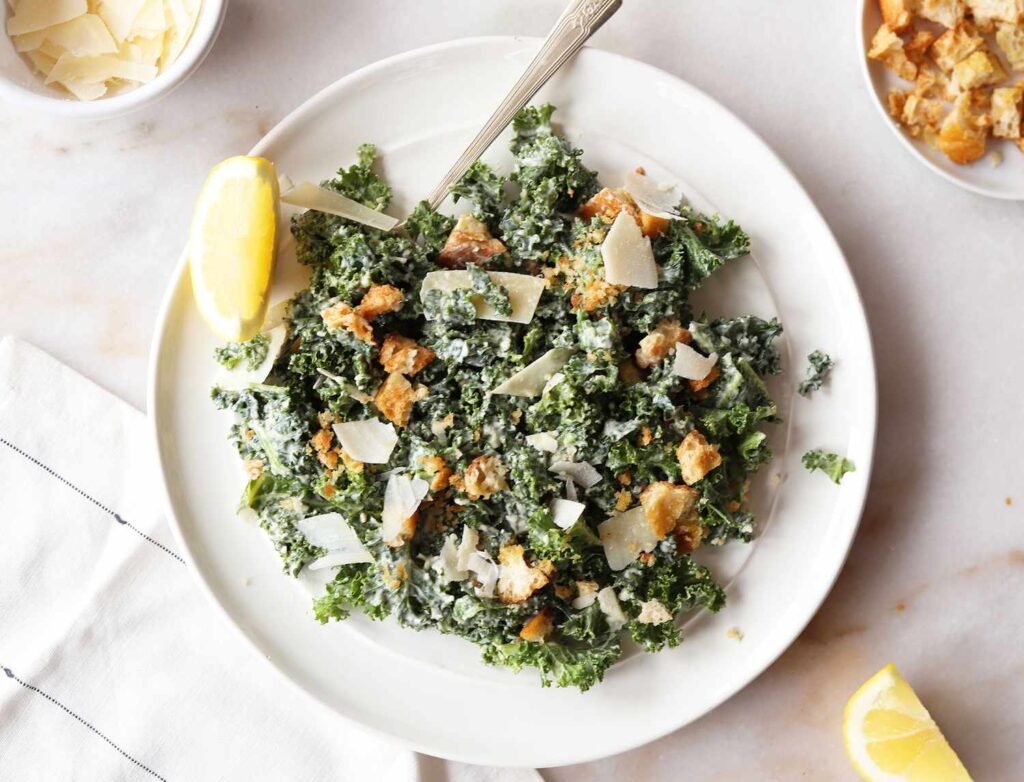
Not all kale is equal. For Caesar salad, the best choice is Lacinato kale (also known as Tuscan kale or dinosaur kale). It has a darker color, softer texture, and less bitterness than curly kale.
Tips for Prepping Kale:
- Remove the stems: They’re too tough to chew.
- Chop the leaves finely or into bite-sized strips.
- Massage the kale: Rub with a bit of olive oil and lemon juice for 2–3 minutes until tender.
Why it matters: Massaging breaks down kale’s tough fibers, making it more enjoyable to eat while keeping its characteristic crunch.
Secret 2: Make a Bold, Anchovy-Free Caesar Dressing
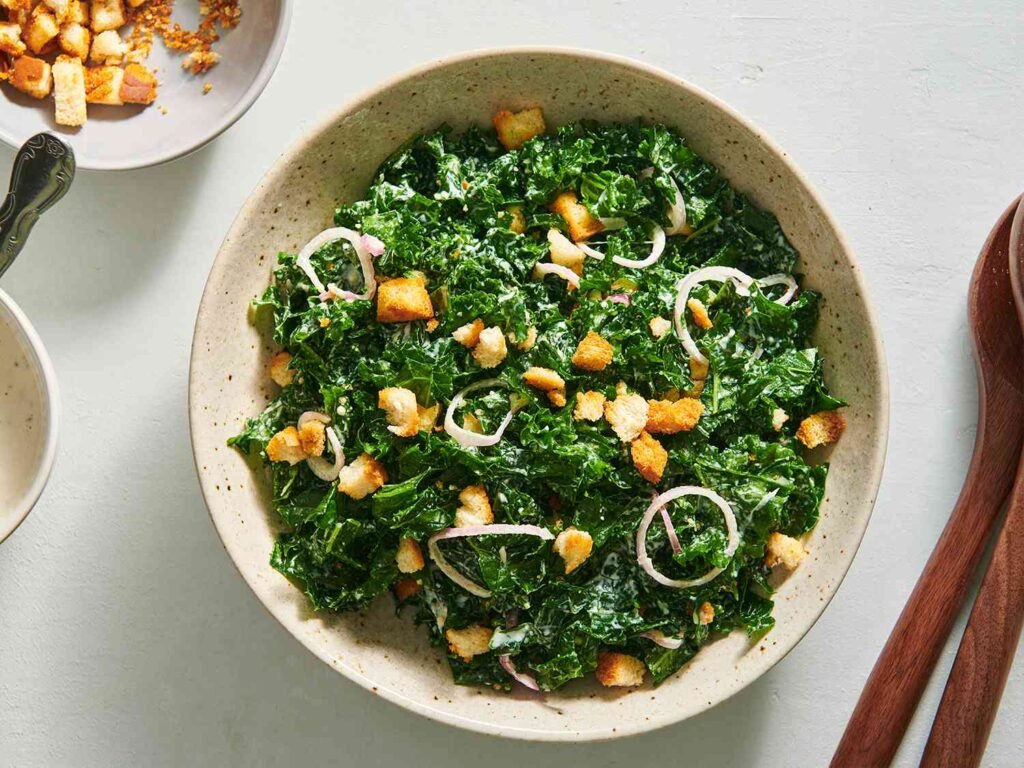
Classic Caesar dressing gets its umami punch from anchovies, but you can replicate that same savory depth with vegetarian alternatives.
Anchovy-Free Caesar Dressing (Vegetarian):
- 2 tbsp tahini or cashew butter (for creaminess)
- 2 tbsp lemon juice
- 1 tsp Dijon mustard
- 1 tsp capers (minced) – adds briny flavor
- 1 tsp soy sauce or tamari – adds umami
- 1 garlic clove (grated or minced)
- 2 tbsp nutritional yeast – cheesy, nutty flavor
- 3–4 tbsp water (to thin)
- Salt and pepper to taste
Whisk until smooth or blend for an extra creamy consistency.
Why it matters: This dressing mimics the traditional Caesar’s tang and umami, without using any animal products.
Secret 3: Use Nutritional Yeast Instead of Parmesan
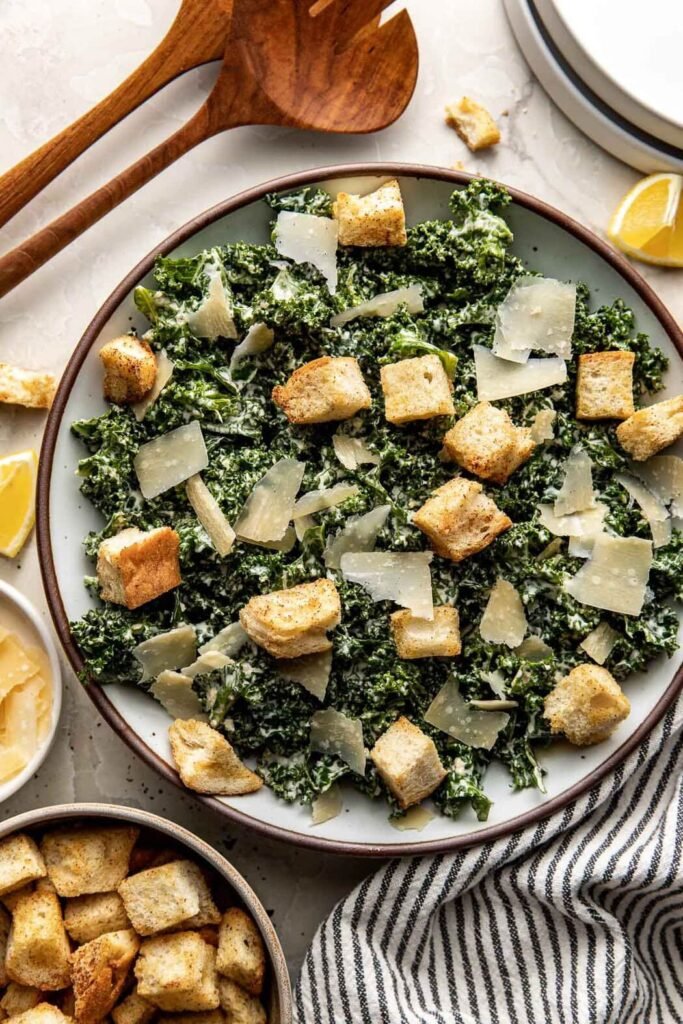
Parmesan cheese typically contains animal rennet, making it unsuitable for vegetarians. Instead, we use nutritional yeast—a pantry-friendly superfood that’s packed with B vitamins and has a naturally cheesy, nutty flavor.
How to Use Nutritional Yeast:
- Add it directly to the dressing.
- Sprinkle some on top of the salad before serving.
- Mix it into croutons for extra depth.
Optional: Use vegetarian Parmesan or vegan Parmesan made from nuts and nutritional yeast.
Why it matters: Nutritional yeast gives the dressing its signature cheesy flavor without compromising on ethics or dietary restrictions.
Secret 4: Don’t Skip the Croutons—Make Them Fresh
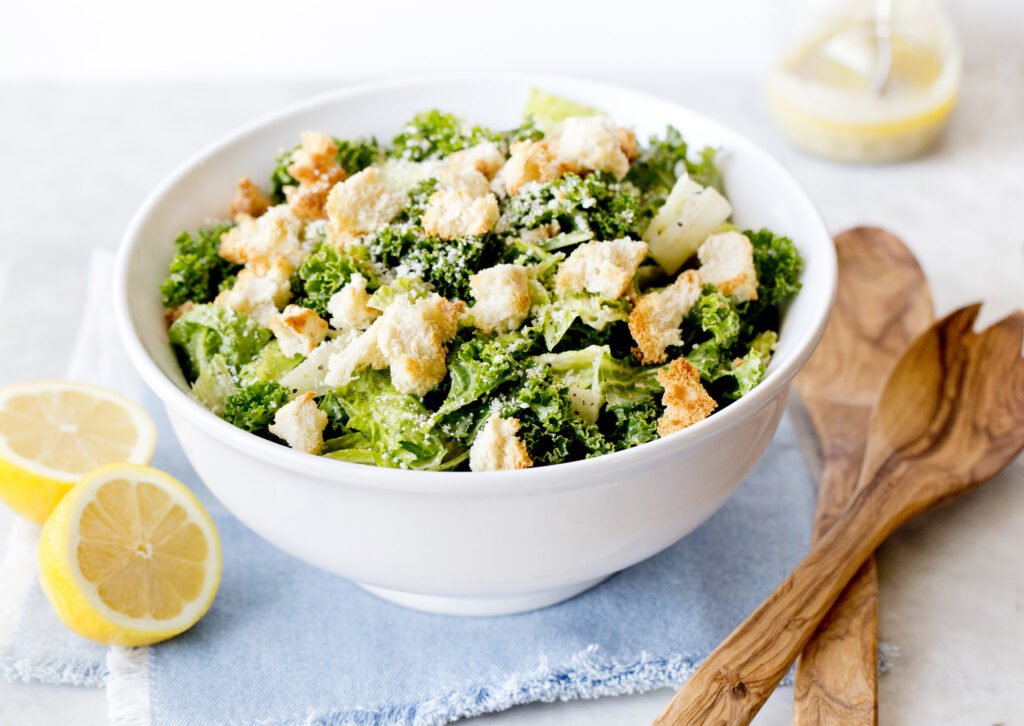
Croutons are the crunch factor in any Caesar salad. While store-bought versions are convenient, they’re often bland or contain additives. Making them at home takes only a few minutes and delivers far better texture and taste.
Easy Homemade Croutons:
- Cut day-old bread (sourdough or whole grain) into small cubes.
- Toss with olive oil, salt, garlic powder, and a bit of nutritional yeast.
- Bake at 375°F (190°C) for 10–15 minutes, flipping halfway.
For extra flavor, add dried herbs like thyme or rosemary.
Why it matters: Fresh croutons stay crunchy, taste better, and can be customized to suit your flavor preferences.
Secret 5: Balance Texture with Add-ins
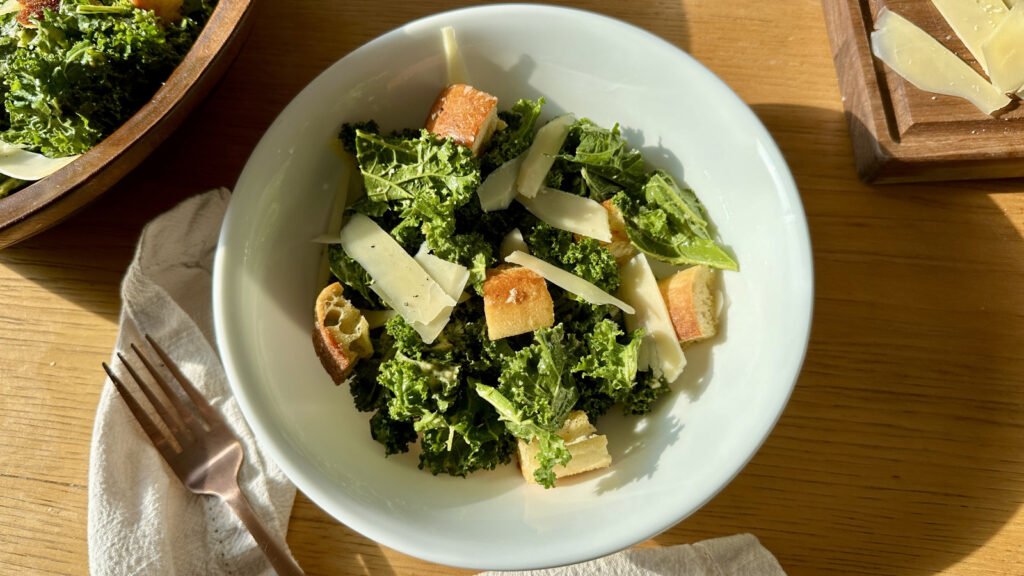
Kale Caesar salad shouldn’t just be about leaves and croutons. To elevate your salad into a main dish, balance it with textural contrasts and extra nutrition.
Great Vegetarian Add-Ins:
- Roasted chickpeas – crunchy and high in protein
- Toasted pumpkin or sunflower seeds
- Shaved radishes – peppery and crisp
- Avocado – creamy counterbalance
- Roasted sweet potato cubes – hearty and naturally sweet
Mix and match to suit the season or your personal preferences.
Why it matters: Contrast in texture keeps every bite interesting, while add-ins turn your salad into a satisfying meal.
Secret 6: Let It Sit Before Serving
Unlike lettuce-based salads, kale can hold up to dressing without going soggy. In fact, it benefits from marinating in the dressing for a short while before serving.
How to Do It:
- After massaging the kale and adding the dressing, let it rest for 10–15 minutes.
- This gives time for the kale to absorb flavors and soften slightly.
Why it matters: Marination makes the salad more flavorful and easier to digest—without losing its crunch.
Secret 7: Use Garlic the Right Way
Garlic is a key component of Caesar dressing, but it needs to be used carefully to avoid overpowering the dish.
Tips for Garlic Use:
- Grate or finely mince garlic for even distribution.
- Roast it for a milder, sweeter flavor.
- If using raw garlic, let it sit in lemon juice for a few minutes to mellow the harshness.
Why it matters: Properly handled garlic enhances depth without creating an unpleasant sharpness.
Secret 8: Add a Burst of Acidity
Every great Caesar salad needs a touch of acidity to cut through the richness of the dressing and complement the hearty kale.
Sources of Acidity:
- Lemon juice – adds brightness and freshness
- A splash of apple cider vinegar – mild and slightly sweet
- Pickled red onions – tangy and colorful
Just a little acidity lifts the entire flavor profile of the dish.
Why it matters: A well-balanced Caesar is never flat—it should be rich, zesty, and crave-worthy.
Secret 9: Garnish with Intent
Garnishing isn’t just about looks—it enhances taste, texture, and aroma.
Smart Garnishes for Kale Caesar:
- More nutritional yeast or vegan Parmesan
- A crack of fresh black pepper
- Microgreens for color and nutrition
- Lemon zest for added brightness
Serve it in a chilled bowl for a refreshing finish.
Why it matters: Thoughtful garnishes complete the dish and elevate it from home-style to restaurant quality.
Sample Recipe: Crunchy Vegetarian Kale Caesar Salad
Ingredients:
- 1 large bunch Lacinato kale, stems removed
- 1 tbsp olive oil (for massaging)
- Juice of ½ lemon
For the Dressing:
- 2 tbsp tahini
- 2 tbsp lemon juice
- 1 tsp Dijon mustard
- 1 tsp capers, minced
- 1 tsp soy sauce or tamari
- 1 garlic clove, grated
- 2 tbsp nutritional yeast
- 3–4 tbsp water
- Salt & pepper to taste
For the Croutons:
- 2 cups cubed sourdough bread
- 1.5 tbsp olive oil
- ½ tsp garlic powder
- 1 tbsp nutritional yeast
Optional Add-ins:
- Roasted chickpeas
- Avocado slices
- Toasted pumpkin seeds
Instructions:
- Preheat oven to 375°F (190°C).
- Toss crouton ingredients together and bake for 12–15 minutes until golden and crisp.
- Remove kale stems, chop leaves, and massage with olive oil and lemon juice until softened.
- Blend or whisk all dressing ingredients until smooth.
- Toss kale with dressing and let sit for 10–15 minutes.
- Add croutons and optional toppings just before serving.
- Garnish with nutritional yeast, pepper, and microgreens.
Conclusion: Caesar Reimagined for a New Era
By applying these 9 secrets, you can transform a classic Caesar into a vegetarian masterpiece that’s just as rich, crunchy, and flavorful—without relying on anchovies or animal-based cheese. The Kale Caesar is perfect for lunches, dinners, or even potlucks, and it holds up beautifully over time.
It’s proof that with the right techniques and high-quality vegetarian ingredients, you don’t have to compromise tradition to honor your values.
